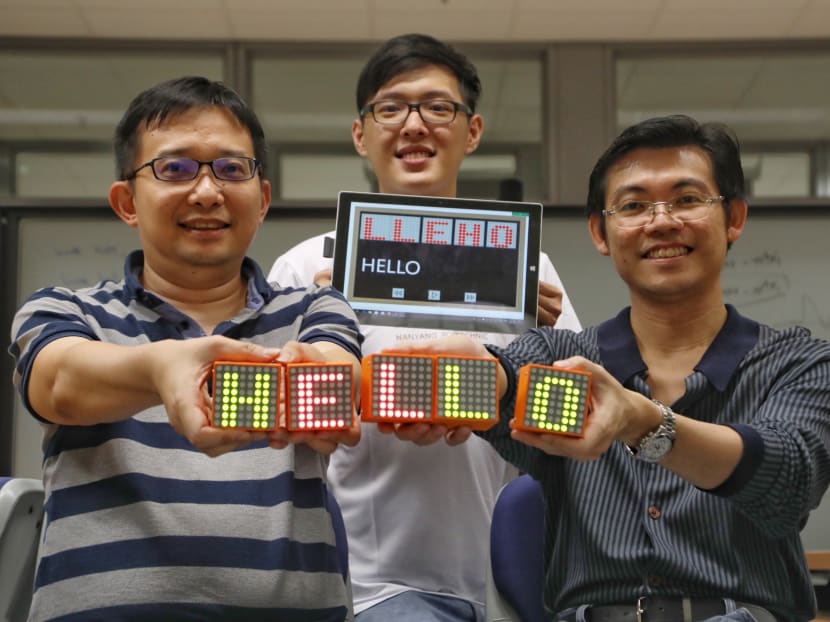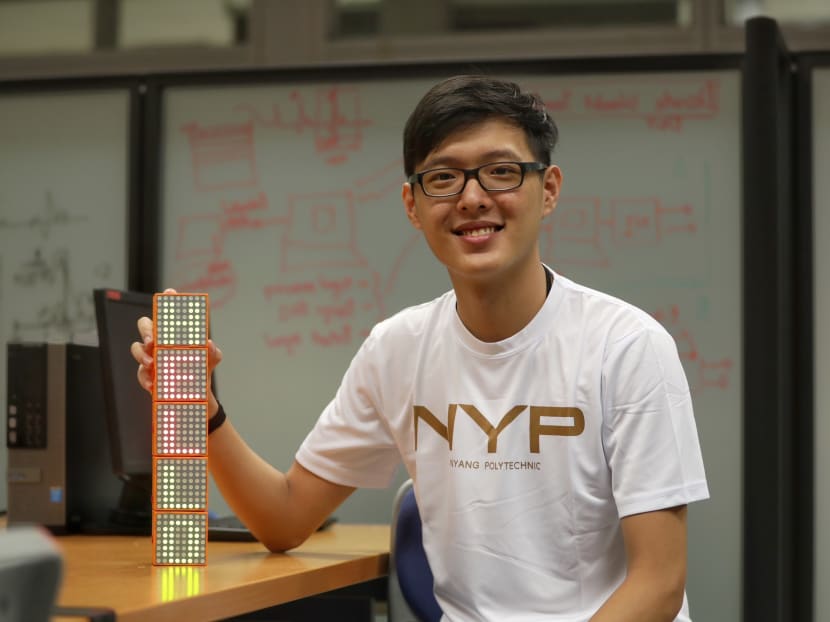Spelling words block by block: Polytechnic students create gadget to help dyslexic children
SINGAPORE — Learning the ABCs may come naturally to most children, but for those with dyslexia, differentiating the small letter “b” from “d” may be challenging because they look similar.

Nanyang Polytechnic lecturers Liaw Sze Wong (left) and Chng Jit Heng (right), together with third-year School of Engineering student Eugene Lee (centre), developed a tool to help pre-school learners with dyslexia. The ProCubeX helps children between the ages of six and eight learn to spell. Photo: Raj Nadarajan/TODAY
SINGAPORE — Learning the ABCs may come naturally to most children, but for those with dyslexia, differentiating the small letter “b” from “d” may be challenging because they look similar.
For dyslexic children, the multi-sensory approach to learning — from sight to sound — is a struggle, which is what a team from Nanyang Polytechnic (NYP) hopes to address with an enhanced teaching tool.
Called the ProCubeX, the cuboid-shaped gadget works with an application loaded with lesson plans of varying difficulty levels.
The cubes display letters electronically and users use them to spell and form words.
Both the cubes and the app also incorporate features such as facial recognition and learning history to build a profile of the student.
NYP student Eugene Lee, 21, who is part of a three-member team behind a third-edition of ProCubeX, said that the app will designate a lesson plan according to the experience, weaknesses and strengths of the user.
"The user will have to form a word using the cubes, and the app will check in regularly to see how far they have gone and what are their strengths and weaknesses," the third-year student from NYP's School of Engineering told TODAY.
As a student progresses through the app, hints will be progressively reduced.

Third-year School of Engineering student Eugene Lee from Nanyang Polytechnic developed a tool to help pre-school learners with dyslexia. The ProCubeX helps children between the ages of six and eight learn to spell. Photo: Raj Nadarajan/TODAY
NYP lecturer Liaw Sze Wong, 46, one of two mentors for the team, said: “We wanted a teaching tool where the children can self-learn. What if I ask the students to form a word and they can't do it? How can we add smart features to slowly prompt and guide (the students) until eventually, they are confident to form the words?"
The function to remove hints for the words were put in for teachers to ascertain that without help or prompts from the app, the children eventually get to spell correctly on their own.
Another feature of the ProCubeX is that it allows teachers to monitor the progress of their students through the use of cloud storage.
NYP lecturer Mr Chng Jit Heng, 43, the other mentor for the team, explained why cloud storage was used: “If you want the teacher to continuously monitor (the child), one of the issues is that when you change a teacher, (the next teacher) may not be able to follow up (with the child's progress). If all (the data) can be stored backend on the cloud, this would be helpful for the teachers as well.”
Mr Chng, whose child is also dyslexic, said that the backend function to retrieve a student's progress data was added to the device after inputs from the Dyslexia Association of Singapore (DAS).
The association’s head of publicity and publications, Ms Deborah Hewes, said: "When teaching young children (with dyslexia), we are always looking for good resources that our teachers can use to help our children understand language. When we saw the ProCubeX and the potential of what can happen in the classroom, we really liked the concept."
However, she noted that the device is still in its early stages, and there is still some work to do before it can be rolled out in a pre-school setting, such as how well it can withstand damage.
"Before you put any product in the classroom, you need to consider how robust it is going to be, whether it is going to take the hard knocks that a child will have when using it in the classroom," she said.
There are plans to test the use of the device in DAS's classrooms. At the moment, teachers at DAS use teaching aids such as phonic cards and worksheets.
As Mr Lee was starting to work on the third version of ProCubeX, he met with the teachers to find out more of what they do and need. "Most of the teaching aids used by (the teachers) are made by themselves, which is why they said they would appreciate an (external) teaching aid that would also integrate their lesson (plans) and needs inside (the gadget),” he said.
Besides overcoming technical and product design difficulties, Mr Lee noted that communication was a challenge with his two other team members, who had worked on the earlier versions of the device and have since graduated.
"(Because of our different schedules), we learnt to split our work based on our skill sets," he added.
For example, he was in charge of the app, while his teammate, Ms Sun Yetong, was focused on the hardware. The third team member, Mr Guo Xihuang, was tasked to integrate the cloud storage function.
The NYP team is refining the product, in preparation for the Microsoft Imagine Cup 2018 World Final in Seattle, United States. The annual global technology competition is organised by Microsoft for students to create and develop applications that support work and play.
Team 7x, as they call themselves, won the Singapore leg of the student technology competition in April, and they will be representing Singapore in Seattle this month, where they will showcase the ProCubeX.
For Mr Lee, the inspiration to create the ProCubeX was personal, too.
His close friend, who was his classmate at Bowen secondary school, is also dyslexic, and had often struggled with school lessons.
"At first, I didn't really think (his learning difficulty) was such a big problem because I didn't experience it," Mr Lee admitted.
"But after doing my research, I thought that if I can help someone with dyslexia, or if I had help my friend back then, perhaps his life would have turned out differently."






